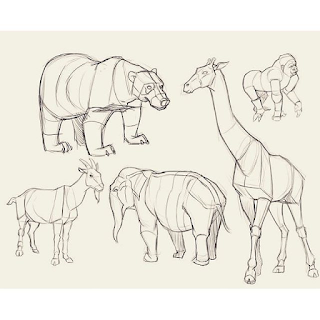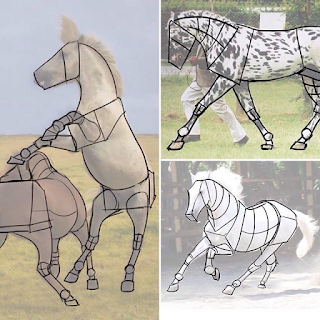So drawing animals from imagination has never been my
strength. It’s always something I've avoided. This is strange because I really
liked to draw monsters, but completely shunned learning animal anatomy because
I considered it boring and hard.
When you’re drawing, you have the habit to stay in your
current lane – you stick to what you’re good at and continuously hammer it in.
The issue with that is that it’s not helping you in any way. All you’re doing
is going through the same motions you've done before and you aren't really
learning anything new. A concept artist,
Carlo Arellano, once told me it’s basically masturbation when you do that – it
feels good drawing something you know you’re already good at.
When you’re learning to draw anything new, it’s necessary to
go through a phase of boring learning. It’s just a necessary phase. Its a big part on
how to draw fantasy art. If you’re
good at drawing a particular thing, your ego tells you that you are "past"
doing the boring stuff – that you already did your time.
But if you listen to your ego here, you’re
going to end up with an imbalance of skill. This is a situation where, for
example, someone’s human subjects look amazing, but their backgrounds are
terrible, or vice versa. Ultimately, you don’t want this to be you – you want
to be a well-rounded artist.
 |
| Studies done for Joe Weatherly Construction Sketches |
So, in this post, I wanted to talk about my personal progression
into being a more well-rounded artist. Five months ago, my animals were at a
beginner’s level, but as of right now, they are “decent.” And that, to me, is
incredibly exciting! I haven't learned to draw anything new in five years or
more. I was stuck in a rut.
I used to draw animals from a picture the same way I drew a
vase. I could copy, but I could never invent.
I had no understanding of what was going on underneath the fur, and I
couldn't understand their skeletal structures, even by just glancing at an
anatomy chart. I couldn't wrap my head around what was going on, ESPECIALLY
when they started moving.
I got some decent images in the past from my method of copying,
but my invention was terrrrrrrrible. I knew it was a gap in my knowledge that I
needed to at least try to fill.
This is a drawing I did five months ago.
It’s an attempt at
a creature invention. Looks like crapola. I can't draw hooves to save my life.
The bumps in the back are just wild guesses as to what they are. The leg is way
too coiled up, more so resembling a human leg than a
horse’s. The nostril is just a hole in his
face.
This is a drawing 4 months later. It’s another invention. It’s
a much improved creature invention. I still have a ways to go, but the
difference in understanding is monumental.
Let me go over the three things I felt made the most
difference for me:
1) On a horse or big cat, the scapula is on the side. This
should be an obvious, but it was something I wasn’t paying enough attention to.
Humans and primates have their scapulae on their back, attached to the
clavicle. Having the scapulae be on an animal’s sides allows for fast mobility.
2) Learning Basic Pivot Points: I learned the bare, basic
structure of a prey animal and a predatory big cat. Basically, I learned where
the pivot points were on these forms and committed those to memory. Once I did
that, I tried finding those pivot points on real images of big cats and prey
animals like deer, giraffes, lamas, horses, donkeys, etc.
Tracing these pivot points over pictures of
the real animals made the BIGGEST difference. I did it 30 times, and still do
it for warm up. It helps you really internalize proportions from real life.
 |
| These are a Few Images I traced over, to find and practice construction and pivot points. |
3) Comparing anatomy: I already had a decent understanding
of human anatomy coming into this. Animal pivot points were the hardest part
for me, and once I felt decently comfortable with them, the anatomy seemed
simpler to compare to the human anatomy I was already familiar with. From an
artistic standpoint, horses and tigers have pretty much most of the same
muscles we have. They have triceps, a gluteus maximus, phalanges, humerus, ect.
These muscles and bones are just in completely different proportions based on how
they were evolved to be used.
 |
| Sketches I did recently from live animals at the San Diego Zoo |
So there you have it. Those are the three biggest things
that helped me out in drawing outside my comfort zone. I'm still a novice, but I
really feel like I'm on a moving path to getting better now.
-Stay Creative!
ps, for more on animals or video tutorials, check out Enzyme Art on Youtube

















